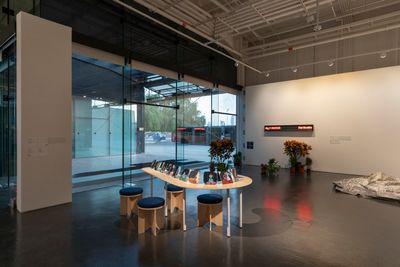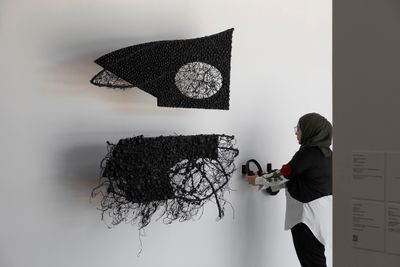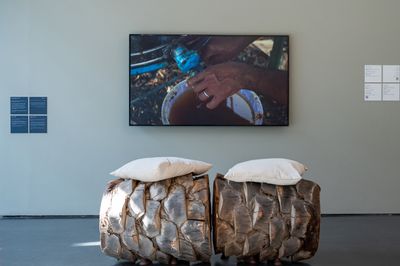
18 Nov ‘Way of the Forest’ in Abu Dhabi: Landscapes Seen and Unseen
Source Credit: Content and images from Ocula Magazine. Read the original article - https://ocula.com/magazine/features/colomboscope-way-of-the-forest-in-abu-dhabi/
The travelling edition of Colomboscope (22 September to 29 December) entices us to learn from the forest—through the urgent practices of artists from Sri Lanka and beyond.
In Ursula K. Le Guin’s sci-fi novel The Word for World Is Forest (1972), inhabitants of a distant, densely forested planet revolt against profit-seeking extraction; they succeed, but at a deep spiritual cost. Le Guin’s anti-colonial and environmental fable inspired the 8th edition of the Sri Lankan arts festival Colomboscope, Way of the Forest, held across various venues in Colombo during January 2024.
Organised by artist and curator Hit Man Gurung with Colomboscope director Natasha Ginwala, together with Sarker Protick, Sheelasha Rajbhandari, and Vidhi Todi, the latest iteration travels to Abu Dhabi’s 421 Arts Campus as an exhibition—where it will be on display for considerably longer than the festival’s original dozen days.
Exhibition view: Colomboscope: Way of the Forest, 421 Arts Campus, Abu Dhabi (22 September–29 December 2024). Courtesy Colomboscope and 421 Arts Campus. Photo: Ismail Noor/Seeing Things.
While the artists in Way of the Forest hail from a broad southern arc, which spans from Southeast Asia through South Asia to Africa, almost half are Sri Lankan. Their works shed light on historical violence across the global South and offer alternative modes of thought and restorative practices from rainforests and riverine wetlands. This seeks to open up ways to learn from the ‘multi-species school of the forest’ and, in turn, think through the broader issue of climate change.
The past decade has seen the concept of the Anthropocene gain incredible currency, not least as a curatorial conceit. The idea that human impact on the planet has become measurable on vast geological scales has its benefits: one is forging a collective sense of being, away from an individualist, consumerist vision of the world.
Sanod Maharjan. Exhibition view: Colomboscope: Way of the Forest, 421 Arts Campus, Abu Dhabi (22 September–29 December 2024). Courtesy Colomboscope and 421 Arts Campus. Photo: Ismail Noor/Seeing Things.
Yet, critics have pointed out how the rather broad-brush term Anthropos (human) evades the more specific questions about who precisely caused these problems, and who has more and less agency. (This has led to the emergence of an entire ‘cene’ scene: ‘capitalocene’, ‘plantationocene’, and ‘chthulucene’, by authors including Andreas Malm and Donna Haraway, among others).
In our collective realisation that the natural environment should not be seen as a resource to be exploited—a ‘standing reserve’, like a supermarket to pilfer from—questions have been raised about how this came to be, the violence that was involved, and the people who have been consequently affected or even dispossessed. By taking its inspiration from the forest, with its legends, unruliness, and capacity to offer refuge, Way of the Forest attempts to present artistic visions that dream of alternative power structures and new world orders.
Jayatu Chakma, Story of the Grey Hills (2022–23) (detail). Exhibition view: Colomboscope: Way of the Forest, 421 Arts Campus, Abu Dhabi (22 September–29 December 2024). Courtesy Colomboscope and 421 Arts Campus. Photo: Ismail Noor/Seeing Things.
Several artists in the exhibition offer the testimonies of marginalised groups, presenting memories and histories that counter dominant narratives. Story of the Grey Hills (2022–23) by the artist Jayatu Chakma, an Indigenous Jumma artist from the Chittagong Hill Tracts of southwest Bangladesh, involved Lushai individuals retelling stories of displacement.1
Like many Indigenous peoples around the world, their land was historically regarded as terra nullius (no man’s land), in effect dispossessing them; the modern nation-state of Bangladesh continued this developmental dynamic with hydroelectric and tourism projects.2 Employing needlework on triangular canvases and cloth installations, Chakma brings to life these tales of earthmoving machinery and flooded lands, of dazzling hornbills and flower-headed figures.
Arulraj Ulaganathan, Hidden (2023) (detail). Exhibition view: Colomboscope: Way of the Forest, 421 Arts Campus, Abu Dhabi (22 September–29 December 2024). Courtesy Colomboscope and 421 Arts Campus. Photo: Ismail Noor/Seeing Things.
A set of works by Arulraj Ulaganathan stands out for its honest power. The son of a female tea picker who worked in a plantation in Haputale in the central hills of Sri Lanka, the artist illustrates the daily physical hardships the workers endured. Venomous snakes, leopards, and elephants lurk, while bruised feet are drawn in delicate detail, edged with haunting tea stains. The workers’ timecards juxtaposed next to their portraits draw attention to the system of control over labour. On the floor, tea powder is strewn as part of an installation where workers are shown not as an abstract mass but as individuals.
MTF Rukshana. Exhibition view: Colomboscope: Way of the Forest, 421 Arts Campus, Abu Dhabi (22 September–29 December 2024). Courtesy Colomboscope and 421 Arts Campus. Photo: Ismail Noor/Seeing Things.
MTF Rukshana’s presentation was, for me, one of the strongest in the exhibition. With woven elements of paper, cloth, and canvas, works like Untitled (2023) and Kiduhu I (2023) bring together geometric abstract weaving patterns and cloths encrusted with seed pods; these pieces span the pictorial and the sculptural. In referencing kiduhu (food baskets woven from leaves used in ceremonies), Rukshana also questions women’s familial roles within systems of patriarchal violence.
Her activist vision has a tangible outcome in her project to teach Sri Lankan women how to weave, enabling them to reclaim some agency through forming weaving communities. Visually, the works are stunning: Untitled, for instance, has woven fabric contorting around tree branches, the tension between nature and textile uniting consummate craft technique with conceptual flair.
Pushpakanthan Pakkiyarajah. Exhibition view: Colomboscope: Way of the Forest, 421 Arts Campus, Abu Dhabi (22 September–29 December 2024). Courtesy Colomboscope and 421 Arts Campus. Photo: Ismail Noor/Seeing Things.
For certain peoples—enslaved, colonised, displaced—the trauma and violence of world-ending destruction has already been visited upon them. As the Martinican poet Aimé Césaire once wrote: ‘The only thing in the world worth beginning: The end of the world, of course.’ Such stains and echoes of ecocide show up in the works of Pushpakanthan Pakkiyarajah, like Mycelium and the Charred Landscape (2022) and Hidden Mycelium in a Wounded Land II (2022–23), where filaments of ink are looped and enmeshed in rhizomic networks. Thriving where forests are damaged, the mycelium bears witness to the vestiges of war and destruction. After breaking down the dead and decaying, however, the fungal growth allows new life to emerge, in a cycle of intergenerational symbiosis and sustenance.
For Pakkiyarajah, these intricate works—which feature a sonic track played on headphones on one side—are part of a broader practice that thinks of and through the land. As he noted in a recent interview, ‘The land is a silent witness to the stories of past and present … rather than focusing on the sensuous scenery that is easily perceived on the surface, the unseen landscape—or what is forced to disappear—interests me more.’
Saodat Ismailova, Arslanbob (2023).
Ways of the Forest also presents alternative modes of envisioning and relating to the natural environment. In the three-channel video work Arslanbob (2023) by Saodat Ismailova, languorous takes of a walnut forest in southern Kyrgyzstan and narrations of spiritual tales draw out historic connections between plants, myths, and mysticism. In retracing the journey of a date seed from the religious preacher Arslanbob to the mouth of the 12th-century Central Asian mystic Ahmad Yasawi, not only are contradictory truths narrated (dates become walnuts, for instance) but the forest takes on a sacred, mystical quality. The supposed hallucinatory effects of the forest might be due to the walnuts’ emission of carbon dioxide.
In an oneiric manner, the work suggests a complex bind of spirituality and fable-making, with a different historical notion of ecological care, from a time before the rational-industrial disenchantment of the world. One only wished the work was afforded a more enclosed space to breathe in the scale and majesty of its subject.
Pathum Dharmarathna, Bhawana (2023). Video.
Other works imagine performative and meditative relations with the forest. In Pathum Dharmarathna’s video work Bhawana (2023), bodily gestures—inspired by the artist’s background in two forms of dance, Kandyan and contemporary, as well as in martial arts and experimental theatre—register the energy of the forest while performing on rock faces, in tree trunks, and on bodies of water.
Karunasiri Wijesinghe. Exhibition view: Colomboscope: Way of the Forest, 421 Arts Campus, Abu Dhabi (22 September–29 December 2024). Courtesy Colomboscope and 421 Arts Campus. Photo: Ismail Noor/Seeing Things.
Elsewhere, poet and artist Thavarasa Thajendran’s sand and rock installations, Araniyam (The Forest) I and Araniyam (The Forest) II (both 2024), manifest earthly reverence through rhythmic patterns. ‘I draw land on the land with elements of the land,’ the artist once said, evoking all the connotations of war and dispossession with which the word ‘land’ is laden in Sri Lanka.
For I Sit Under Your Shade (2022), UAE-based artist Nahla Al Tabbaa drew shadows under trees, documenting how the movement of the sun inscribes moments of observation and leisure in this contemplative charcoal-on-canvas installation that stretches out casually from one corner of a room.
Karachi LaJamia. Exhibition view: Colomboscope: Way of the Forest, 421 Arts Campus, Abu Dhabi (22 September–29 December 2024). Courtesy Colomboscope and 421 Arts Campus. Photo: The Frei.
Exploring the politics of representation and the archive is Mauritian artist Shiraz Bayjoo’s Botanical Shrines (2024). In an installation that serves as an altar to survival and resistance, the artist delves into how native plants in countries bordering the Indian Ocean were destroyed to make way for plantations. Seeds, pods, and shells—having served historically as currency—are juxtaposed with beguiling portraits of plants, gesturing at how extraction works through amassing botanical specimens as well as through scientific knowledge.
Moza Almatrooshi. Exhibition view: Colomboscope: Way of the Forest, 421 Arts Campus, Abu Dhabi (22 September–29 December 2024). Courtesy Colomboscope and 421 Arts Campus. Photo: The Frei.
Forests might, at first blush, seem distant from deserts—and from binary stereotypes of the Gulf. As the director of 421 Arts Campus, Faisal Al Hassan, points out, however, forests and deserts have remarkable similarities, with ‘a shared unruliness, resilience, and independence’. Both harbour rich folklores and mysticisms; both have served historically as sanctuaries. Moreover, not only do links between the Gulf and the subcontinent date back centuries but, in recent times, migrants from the subcontinent have worked in the furniture warehouses and produce markets close to where 421 Arts Campus currently stands.
Yet, despite the exhibition’s fantastic interpretive efforts—signage appears in Sinhalese and Tamil as well as Arabic and English; tactile interpretive exercises are provided for children—I couldn’t help but feel there was still something askew. Was it simply due to the sense of dislocation that emerges when works embodying ‘unruly’ ideas are displayed in a clean, white-cube setting, causing the wonder and whimsy of the forest to feel ‘hemmed in’? Or was I just craving works that explored local conditions in tune with the urgent practices highlighted in Way of the Forest? I’m not sure. Nonetheless, the exhibition does succeed in raising thought-provoking questions in captivating ways—and guiding viewers to see how violence, extraction, and displacement are ever-rife in the world today. —[O]
Way of the Forest is the 8th edition of the Colomboscope arts festival held in Colombo, Sri Lanka, from 19–28 January 2024. This iteration of the festival at 421 Arts Campus has been adapted to reach audiences in the UAE, and marks the second time partnering with Colomboscope.
1. The Jumma, Lushai, and other Indigenous peoples of the Chittagong Hill Tracts can be broadly categorised as “Mizo“. By some accounts, “zo” refers means to ‘”highland'” or ‘”remote'”; this “zo” is also in the term “Zomia“, coined by the historian Willem van Schendel, referring to the uplands of Southeast Asia, whose people have historically been beyond the reach of lowland governments. This resistance to state power was also incisively explored in James C. Scott’s The Art of Not Being Governed (2009), influencing many scholars and curators of the region.
2. https://www.dhakatribune.com/opinion/op-ed/198145/communities-under-threat and https://www.ecoi.net/en/file/local/1413592/ds8_02185ban.pdf
Source Credit: Content and images from Ocula Magazine. Read the original article - https://ocula.com/magazine/features/colomboscope-way-of-the-forest-in-abu-dhabi/











